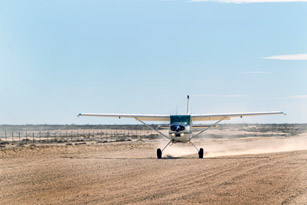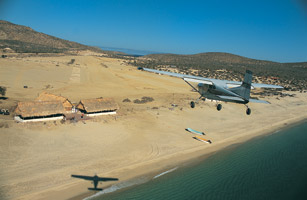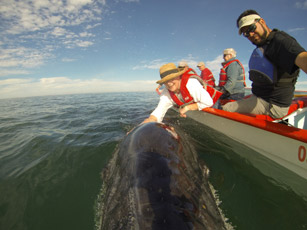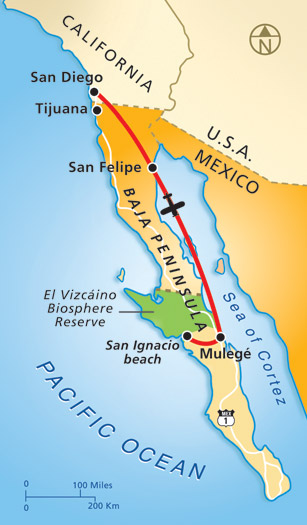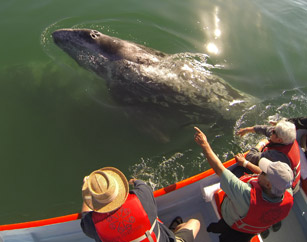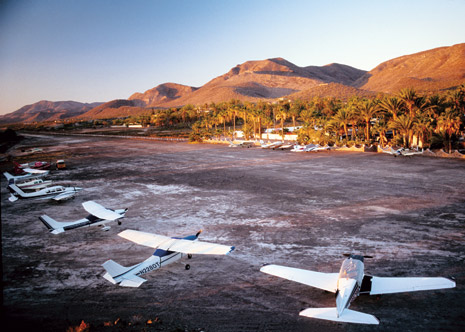
Dawn casts the barren Pacific coast of the Baja Peninsula in a soft light as we overfly the dusty airstrip at San Ignacio while numerous spouts—some just a few hundred yards offshore—assure us that the California gray whales we’ve come to see are here in abundance.
Three expansive inlets in this arid, sparsely populated region about two-thirds of the way down the 700-nm Baja Peninsula are a sanctuary for the majestic, once-endangered whales that breed and bear their calves here each winter, then migrate 6,000 miles north to Alaska’s Bering Sea in the summer. And the chalky, gravelly, north/south airstrip at San Ignacio is becoming a popular spot for general aviation pilots and their passengers to come for close encounters with whales that reside here from January until early April.
Getting here in a Cessna 185 involved crossing the border near San Diego, flying 150 nm southeast to San Felipe to fill the tanks and clear Mexican customs, then following the emerald Sea of Cortez coastline for 283 nm to Mulegé for an overnight stay. This morning, a scenic 30-minute traverse of the craggy peninsula at first light brought us the rest of the way. John Kounis, founder of Pilot Getaways magazine, owns and flies the Cessna 185 and is an experienced Baja traveler but, as with AOPA Senior Photographer Mike Fizer and me, this is his first landing at the whale sanctuary.
“We’re really getting lucky with the weather because there’s often fog and a low marine layer on the west coast,” Kounis says. “Glad we don’t have to deal with any of that today.”
Visibility is unlimited, and a steady and dry five-knot breeze comes from the northeast. The graded dirt runway is about 50 feet wide and 5,000 feet long, but a soft, sandy portion is blocked by a barrier of tires. That leaves about 3,000 feet of usable runway for the 185, more than enough as Kounis approaches at 65 KIAS, touches down at 50, and uses less than 1,000 feet of runway on rollout.
All aircraft at nontowered strips in Baja use 122.8 MHz as a CTAF, but the frequency has been quiet all morning. Two other airplanes, a Cessna 208 Caravan and a Mexican-registered Twin Commander, are parked in front of the airport’s lone wooden shack. We taxi there and shut down in a cloud of dust.
We haven’t made reservations with any of the companies that offer whale-watching tours here, and we aren’t sure how we’re going to make the three-mile trip to the bay. But those uncertainties are instantly resolved as a yellow former school bus carrying a dozen U.S. visitors deposits them at the Caravan for their flight home. A Baja Expeditions guide, Alejandro “Alex” Romero, offers us a ride in his Chevy pickup, three places on a boat leaving in 30 minutes, and lunch—all for $50 apiece. (There’s also a $20 landing fee at San Ignacio.)
Romero tells us there are about 250 whales in the sanctuary, and up to a dozen skiffs, or “pangas,” are allowed into the preserve at a given time.
The whale watching camp is rustic compared to the full-service resorts that have become almost synonymous with Mexico tourism. But at a time when traditional resorts are struggling from lingering U.S. economic weakness and fear of drug violence, Baja Adventures’ three- and five-day “eco-tours” here are booked months in advance. Visitors typically board vans in San Diego, drive across the border to Tijuana International Airport, and fly about 2.5 hours in a chartered Caravan to get here. Or they provide their own transportation and stay in the wooden safari-style huts on the bay.
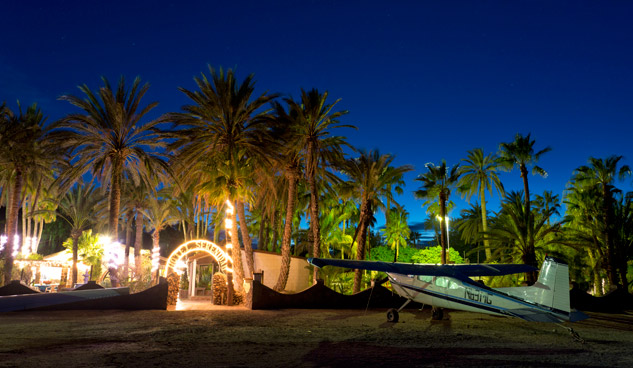
Whale watching takes place twice a day, and there are sea kayaks for exploring mangrove portions of the bay and spotting exotic seabirds. Electricity at the camp is generated on site through solar and wind power, and a small desalinization station provides fresh water.
Kounis, Fizer, and I share a 22-foot panga with five fellow Americans, all visitors from Arizona, and marvel at the whales—some of them twice as long as our boat—that cavort close by. A few surface right next to us, apparently curious, and linger with long stares, before smoothly descending below the choppy surface. Mothers with newborn calves beside them seem proud to show off their young ones.
The situation couldn’t be more different from the late nineteenth century when whalers nearly wiped out this entire species at this very place. They harpooned the whales in huge numbers as they came and went through the narrow mouth of the inlet, set up boilers on the beach, and converted blubber into whale oil in large volume. Some of the metal pots they used for that purpose are still present, rusting on shore.
Whalers called the whales “devil fish” because they were known to angrily charge boats when pursued. The whale population declined to fewer than 2,000 by the time whale oil fell out of commercial use and hunting whales in this region was outlawed in 1947. In the 1970s, a Japanese firm proposed draining the entire lagoon and turning it into a massive salt collection area. The move would have devastated the whale population. But with financial support from international environmental groups, the Mexican government made the area a permanent marine sanctuary.
Gray whales now number more than 20,000 and were taken off the endangered species list in 1994. They still face threats— but none as potentially catastrophic as the complete destruction of their main breeding area. Local fishermen still regarded the whales as dangerous, however, and stayed away from them. That began to change in the 1980s, when whales with no memory of being hunted began to approach small boats with curiosity. Some of the fishermen even began petting the whales with bare hands.
Word of these unlikely encounters spread, and visitors hired local fishermen as guides, seeking the possibility of getting close to the 40-ton animals. Such intimacy isn’t guaranteed. Sometimes the whales prefer to stay away. But even when they’re feeling standoffish, the whales can be seen raising their massive heads out of the water to survey the area, playfully rolling on their sides, and chaperoning their young through the calm, shallow waters. The growth in environmental tourism provides an economic incentive for ongoing protection.
After a day on the water, we get back in the 185 and fly 30 minutes across the peninsula to the town of Mulegé on the Sea of Cortez. The dirt strip there at Hotel Serenidad ($65 a night) has long been a favorite among Baja pilots, and aircraft are guarded by soldiers at a full-time army post adjoining the runway.
GA flying in Baja has been a casualty of the ongoing threat of drug violence and lawlessness. The Mexican government has clamped down on smugglers by limiting avgas sales to tower-controlled airfields such as San Felipe to the north and Loreto to the south. But the distances between those locations can be too great for some GA aircraft to comfortably travel, especially with the stiff winds that are common in this region.
The 185 we’re flying has extended-range tanks that boost fuel capacity to 99 gallons. But after filling up in San Felipe, then flying to Mulegé, San Ignacio, and back to Mulegé, a 30-knot headwind makes the margin too close to return to San Felipe on our trip north. Instead, we must go 65 nm south to Loreto to fill up before heading north again.
“It used to be that you could fill up just about anywhere, and that gave pilots a great deal of flexibility to drop in on new places and explore Baja,” Kounis said. “Now, that’s not so easy.”
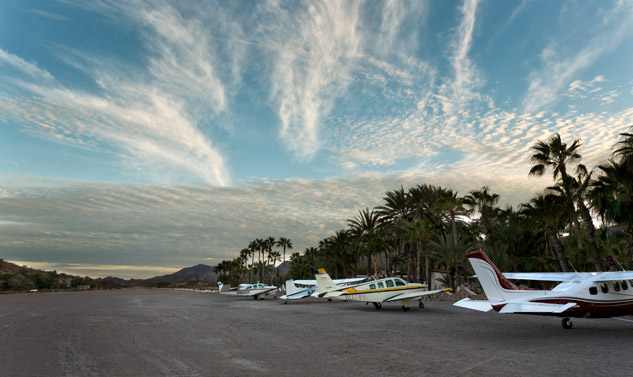
At Loreto, we file our eAPIS computerized Customs notification, and then fly five hours into a headwind all the way back to San Diego’s Brown Field. We are able to modify our eAPIS arrival time en route with a radio call to San Diego Flight Service, and Tijuana Approach seamlessly coordinates our arrival into the traffic pattern at Brown. The process of clearing U.S. Customs goes smoothly and quickly, but the number and type of airplanes on the ramp illustrate recent (and regrettable) changes in Baja flying.
“There used to be a line of single-engine piston airplanes at Brown on any given day, and all of them were full of people returning from flying vacations in Baja,” Kounis said. “Now, there are jets and turboprops that mostly go to mainland Mexico, Cabo San Lucas, or the Caribbean. The amount of GA flying in Baja has dropped way off—and that’s tragic for visitors, and businesses that depend on them.”
Airfields at once-popular fly-in vacation spots such as Bahia de Los Angeles and Punta San Francisquito on the Sea of Cortez are largely vacant, and their dirt runways are seldom used by GA pilots from the United States.
Many visiting U.S. pilots like Kounis are only willing to stay overnight at airports with full-time security. Fortunately, many small airports have army posts attached to them, but the heavily armed young soldiers are a constant reminder of the underlying threat.
“You used to hear U.S. pilots all the time on 122.8 as they reported their positions traveling up and down the peninsula,” Kounis said. “Now the frequency is so silent it’s spooky. That’s really unfortunate because so much beauty and adventure is still so accessible in Mexico.”
Email [email protected]
For more information on flying in Baja, visit these websites:
